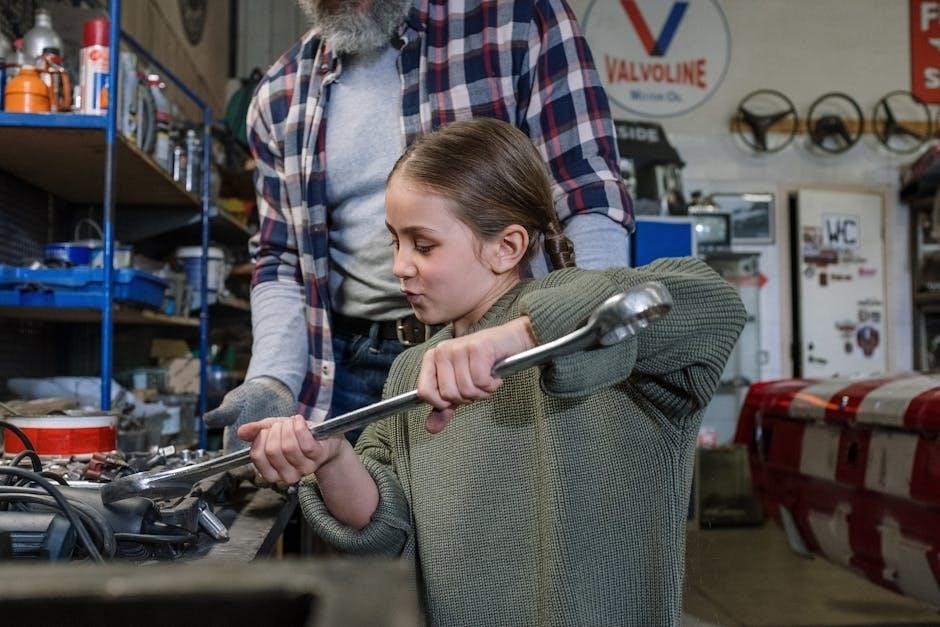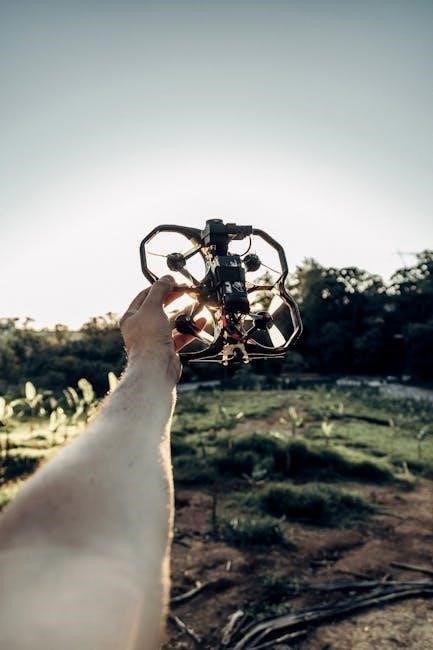Remote starting and manual transmissions present unique challenges due to their incompatibility․ While remote start systems are convenient, they often don’t work with manual transmissions․
Manual transmissions require clutch engagement, which remote systems can’t handle․ However, workarounds like push-starting or aftermarket solutions exist for manual vehicles with dead batteries․
Understanding these limitations is crucial for car owners seeking to combine remote start technology with manual transmissions, ensuring safety and proper vehicle operation․
What is Remote Start Technology?
Remote start technology allows drivers to start their car’s engine from a distance using a remote control or smartphone app․ This system provides convenience, enabling pre-heating or cooling the vehicle before entry․ It typically involves a receiver, control module, and actuators to simulate key ignition and ignition start․ While common in automatic vehicles, manual transmissions pose challenges due to the need for clutch engagement․ Despite this, remote start systems remain popular for their comfort and practicality, especially in extreme weather conditions․
Understanding Manual Transmissions
A manual transmission requires driver engagement to shift gears using a clutch pedal and gearshift․ It relies on the driver to manually synchronize gear changes with engine speed․
Starting a manual car involves pressing the clutch, shifting to neutral, and turning the ignition․ Push-starting is an alternative method for vehicles with a dead battery․
Manual transmissions offer control and efficiency but lack the convenience of automatics, especially in stop-and-go traffic․ They require skill and practice to operate smoothly․

Why Remote Start and Manual Transmissions Are Less Common

Remote start systems are less common in manual transmissions due to the clutch pedal’s necessity for engine engagement․ Unlike automatics, manuals require physical clutch interaction, which remote systems can’t replicate․
This incompatibility makes remote starts less practical for manual vehicles․ Additionally, the complexity of integrating remote start with manual transmissions deters manufacturers and drivers, limiting their widespread adoption․
While workarounds exist, such as push-starting, they lack the convenience of true remote start systems, further reducing their popularity among manual transmission owners․

How Remote Start Systems Work
Remote start systems use a key fob to send signals to the vehicle, activating the engine without physical interaction․ They rely on advanced electronics and sensors․

The system verifies the signal, disengages the immobilizer, and initiates engine startup․ Modern systems often integrate with alarms and offer features like temperature control․
These systems enhance convenience but require precise installation to ensure proper functionality and safety․
Basic Components of a Remote Start System
A remote start system typically includes a remote transmitter, a control module, an ignition relay, a starter motor relay, and an antenna․ The remote transmitter sends a signal to the control module, which processes the command and activates the ignition and starter relays․ These relays then power the ignition system and engage the starter motor to crank the engine․ The antenna ensures strong signal reception, even from a distance․ Together, these components enable the vehicle to start without physical interaction, providing convenience for drivers in various weather conditions․
How Remote Start Engages the Engine
A remote start system engages the engine by sending a signal from the key fob to the vehicle’s computer, which authenticates the command and initiates the starting process․
The system checks if the vehicle is in a safe state, such as neutral gear and the brake disengaged, before activating the starter motor․
For automatic transmissions, this process is seamless, but manual transmissions require additional steps, like clutch bypass, to avoid stalling or damage․
Once conditions are met, the engine starts, and the system ensures smooth operation until the driver takes control․
Role of the Clutch in Manual Transmissions
The clutch plays a critical role in manual transmissions by disconnecting the engine from the transmission, allowing smooth gear shifts․ Pressing the clutch pedal disengages the engine’s power, preventing gear grinding․ In remote starting, the clutch isn’t automatically engaged, making it incompatible with manual transmissions․ This mechanical requirement creates a significant obstacle for remote start systems, as they can’t replicate the clutch pedal’s function․ Without a workaround, manual vehicles can’t be remote-started, highlighting the clutch’s essential role in manual operation․
Challenges of Remote Starting a Manual Transmission
Manual transmissions require clutch engagement, which remote start systems cannot automate, making them incompatible without specialized solutions․

Potential risks include unintended vehicle movement and damage if the clutch isn’t properly managed during remote starting․
Manufacturers often avoid supporting remote start for manuals due to these challenges, requiring aftermarket workarounds for functionality․
Why Manual Transmissions Resist Remote Start
Manual transmissions resist remote start due to the mechanical requirement of clutch pedal engagement․ Remote start systems typically rely on electronic signals to crank the engine, but they cannot physically press the clutch pedal, which is essential for starting a manual transmission vehicle․ This creates a fundamental incompatibility, as the system cannot disengage the clutch or shift gears automatically․ Without a physical intervention, remote starting a manual transmission is not feasible, making it less practical compared to automatic transmissions․
The Clutch Pedal Requirement
Manual transmissions require the clutch pedal to be pressed to start the engine, which remote start systems cannot do․ This makes remote starting incompatible with manual vehicles․
Without the clutch engaged, the car won’t shift into gear, preventing the engine from starting․ This safety feature ensures the vehicle doesn’t move unexpectedly․
However, some workarounds exist, like push-starting or aftermarket systems, but they require careful handling to avoid damage or accidents․
Potential Risks of Remote Starting a Manual
Remote starting a manual transmission vehicle poses significant risks, including unintended movement if the clutch isn’t properly engaged․ This can lead to accidents, especially in confined spaces․ Additionally, remote starting systems may not account for the manual transmission’s unique requirements, potentially causing mechanical stress or damage to the clutch and transmission․ There’s also a risk of legal liability if the vehicle isn’t properly secured and causes harm or property damage․ These risks highlight the importance of proper setup and precautions when attempting remote start on a manual vehicle․
Workarounds for Remote Starting a Manual
Push-starting or bump-starting is a common workaround for manual transmissions with dead batteries․ Start with the transmission in neutral and clutch fully released for safety․
Aftermarket systems can bypass the clutch requirement, enabling remote start functionality․ Ensure proper installation to avoid mechanical damage or legal issues․
Using a Remote Start with a Clutch Bypass
A clutch bypass system allows remote starting in manual transmissions by automating clutch engagement․ This setup enables the engine to start without manual clutch pressing․
The bypass actuator engages the clutch momentarily during startup, mimicking the driver’s action․ This maintains the manual driving experience while adding remote start convenience․
Clutch bypass solutions are ideal for drivers in cold climates who want to retain their manual transmission’s unique feel․ However, installation can be complex and may require professional assistance․
Push-Starting a Manual Transmission
Push-starting, or bump-starting, is a method to start a manual transmission vehicle with a dead battery․ It involves rolling the car and engaging the clutch to restart the engine․
This technique requires safety precautions, as improper use can damage the transmission or cause accidents․ It’s a temporary solution for dead batteries but doesn’t replace proper repairs․
While not a remote start solution, push-starting is a practical workaround for manual vehicles, ensuring drivers can get back on the road quickly in emergencies․
Aftermarket Solutions for Manual Transmissions
Aftermarket solutions offer creative ways to enable remote starting for manual transmissions․ Specialized bypass modules or custom systems can be installed to mimic clutch engagement, allowing remote start functionality․
These systems often require professional installation and may involve additional hardware to ensure safe and proper operation․ While they provide a workaround, they may not be as seamless as factory-installed remote start systems․
Such solutions are popular among enthusiasts who want to retain manual transmission benefits while enjoying modern convenience features, though they may come with safety and legal considerations․

Safety and Legal Considerations
Remote starting a manual transmission poses safety risks, as unauthorized starting can lead to accidents․ Legal implications vary by region, with some areas restricting such modifications․
Always ensure compliance with local laws and prioritize safety to avoid potential legal or insurance issues when modifying your vehicle’s starting system․
Safety Risks of Remote Starting a Manual
Remote starting a manual transmission poses significant safety risks․ If the vehicle isn’t properly secured, it may roll or move unexpectedly, causing accidents or injuries․
The clutch pedal must be engaged to start the engine, and improper bypass methods can lead to transmission damage or unintended vehicle movement․
Additionally, unauthorized starting increases theft risks, and improper installation can cause electrical hazards or fires․ Always ensure proper safety measures and professional installation to mitigate these risks․
Legal Implications of Remote Starting a Manual
Remote starting a manual transmission vehicle may raise legal concerns․ In some regions, modifying a vehicle to enable remote start on a manual transmission could violate local vehicle codes․

Additionally, liability issues may arise if an accident occurs due to improper remote start installation or usage․ Insurance companies may deny claims if the system is deemed unauthorized or non-compliant․
It’s essential to check local laws and ensure any remote start system is installed correctly and legally approved to avoid fines or legal repercussions․
Insurance and Liability Concerns
Installing a remote start system on a manual transmission vehicle may raise insurance and liability issues․ Unauthorized modifications can void warranties or insurance coverage․
Accidental starts or improper use of remote start systems could lead to accidents, increasing liability risks․ Drivers must ensure their insurer approves such modifications․
Professional installation and adherence to safety guidelines are crucial to avoid legal complications and maintain valid insurance coverage․

Modern Solutions for Remote Starting Manuals
Some modern cars now offer remote start for manuals, using advanced systems to handle clutch engagement safely․ These systems ensure smooth starts without driver input․
Advanced aftermarket kits are also available, designed specifically for manual transmissions․ They bypass traditional clutch requirements, offering a seamless remote start experience for manual vehicles․
These innovations address historical incompatibilities, making remote start accessible to manual transmission enthusiasts while maintaining safety and performance standards․
Cars with Built-In Remote Start for Manuals
Some modern vehicles now offer built-in remote start systems compatible with manual transmissions․ These systems typically require the car to be in neutral gear and the clutch pedal fully released․
Brands like Subaru and Mazda have introduced models with this feature, ensuring safety and convenience․ The remote start engages only when certain conditions are met, preventing accidental starts․
For older models, aftermarket solutions or push-starting remain practical alternatives․ Always consult the vehicle’s manual for specific remote start compatibility and safety guidelines․
Advanced Remote Start Systems for Manuals
Advanced remote start systems for manual transmissions use specialized modules or bypass kits to address the clutch engagement issue․ These systems often include sensors and actuators to momentarily engage the clutch during startup, mimicking driver input․ Some modern solutions integrate with the vehicle’s computer to ensure smooth operation․ While these systems are effective, they typically require professional installation and may void warranties․ Despite the complexity, they offer a reliable way to enjoy the convenience of remote starting in manual vehicles, though compatibility remains limited to specific models․
Future of Remote Start Technology
Advancements in smart technology and IoT integration are reshaping remote start systems․ Future systems may incorporate AI-driven solutions to better accommodate manual transmissions, ensuring seamless engine engagement without physical clutch input․
Electric vehicles and hybrid models are expected to influence remote start innovations, offering enhanced compatibility with manual transmissions․ Smartphone app integration will likely improve, providing users with greater control and convenience․
As technology evolves, remote start systems for manuals will become safer, more efficient, and widely available, addressing current limitations and offering drivers unparalleled flexibility․
DIY vs․ Professional Installation
DIY remote start installation can save money but requires technical skills․ Professional installation ensures reliability and safety, especially for complex manual transmissions․
Pros and Cons of DIY Remote Start Installation
DIY remote start installation can save money and be a rewarding project for car enthusiasts․ It allows customization to fit specific needs and can be a learning experience․
However, DIY installations risk damaging the vehicle’s electrical system or voiding warranties․ Manual transmissions add complexity due to the clutch pedal, requiring additional components for safe operation․
Without proper knowledge, DIY attempts may lead to safety hazards or system malfunctions, making professional installation a safer choice for many car owners․
Benefits of Professional Installation
Professional installation ensures proper integration of remote start systems with manual transmissions, minimizing risks of damage or malfunction․
Experts handle complex wiring and clutch bypass setups, guaranteeing reliability and safety, which is critical for manual vehicles․
Professionals offer warranties and post-installation support, providing peace of mind and addressing potential issues promptly․
This approach ensures seamless functionality, avoiding common DIY pitfalls and ensuring the system works efficiently in various conditions․
Cost Comparison: DIY vs․ Professional
DIY remote start kits for manual transmissions cost between $50 to $200, offering affordability but requiring technical expertise․ Professional installations range from $200 to $600, including labor and warranties․
While DIY saves money upfront, it may lack advanced features and compatibility․ Professional setups ensure reliability and proper integration, often justifying the higher cost for long-term convenience and safety․
Factors like vehicle complexity and system quality influence final pricing, making professional installation a worthwhile investment for many car owners seeking a hassle-free solution․
Maintenance and Troubleshooting
Regularly check remote start systems for wiring issues or sensor malfunctions․ Ensure the clutch pedal is properly aligned to avoid engagement problems in manual transmissions․
For troubleshooting, reset the system or consult a professional if issues persist․ Proper maintenance ensures reliable performance and prevents unexpected failures․
Common Issues with Remote Start Systems
Remote start systems often face challenges with manual transmissions due to the need for clutch engagement․ The primary issue is the inability to press the clutch pedal automatically, which prevents the engine from starting․ Additionally, many systems are designed for automatics, leading to compatibility problems and inconsistent starting․ Safety risks arise if the vehicle moves without a driver, and user errors can occur when operating the system without understanding its limitations․ These factors make remote starting less reliable for manual vehicles compared to automatics․
How to Maintain Your Remote Start System
Regular maintenance is essential to ensure your remote start system functions reliably․ Start by checking the battery health and ensuring all electrical connections are secure and free from corrosion․ For manual transmissions, verify that any aftermarket solutions, like a clutch bypass, are properly calibrated and functioning․ Additionally, keep the system’s software updated to the latest version provided by the manufacturer․ Finally, test the remote start periodically under various conditions to identify and address any potential issues before they become major problems․
Troubleshooting Tips for Remote Start
When issues arise with remote start systems, check the battery and connections first․ Ensure the clutch bypass is functioning correctly for manual transmissions․
Look for dashboard error lights and consult the user manual for specific codes․ Verify the remote’s signal strength and range, and test it in different locations․
If problems persist, inspect the wiring and fuses․ For aftermarket systems, ensure compatibility with your vehicle’s make and model․ Contact a professional if troubleshooting fails․

Real-World Applications and Examples
Remote starting is often used in older muscle cars with manual transmissions, allowing drivers to start the engine in neutral with the clutch pedal released for convenience․
Remote Start in Older Muscle Cars
Classic muscle cars with manual transmissions often lack modern remote start features, but enthusiasts find workarounds․ Starting the engine with the transmission in neutral and clutch released is a common method․ For older models with dead batteries, push-starting is a practical solution․ Aftermarket remote start systems can be installed, though they require careful setup to avoid damaging the vehicle․ These modifications allow owners to enjoy the convenience of remote starting while preserving the iconic feel of their manual transmission muscle cars․
Remote Start in Modern Manual Vehicles
Modern manual vehicles are overcoming the remote start challenge with advanced systems․ Some high-end cars now offer remote start compatibility, using electronic clutch actuation or specialized software to engage the clutch during startup․
Brands like Porsche and BMW have introduced remote start options for select manual models, ensuring convenience without compromising driving dynamics; These systems typically require additional sensors and programming to function safely and effectively․
While still rare, such innovations show the potential for remote start technology to coexist with manual transmissions, appealing to enthusiasts who value both convenience and driver engagement․
Case Studies of Successful Remote Start Installations
Several enthusiasts have successfully installed remote start systems in manual transmission vehicles․ One case involved a classic muscle car with a manual gearbox, where a custom bypass module was used to engage the clutch electronically․ Another example featured a modern hatchback with an aftermarket remote start kit specifically designed for manuals․ Both installations required precise wiring and clutch pedal integration to ensure smooth engine starts․ These cases demonstrate that, with the right components and expertise, remote starting a manual transmission is achievable and reliable․
Remote starting a manual transmission is challenging due to clutch engagement requirements․ However, solutions like push-starting or aftermarket systems exist․ Car owners should understand these aspects for safe and proper vehicle operation;
Remote starting a manual transmission vehicle is challenging due to the clutch pedal requirement, which remote systems cannot engage․ While push-starting is a workaround for dead batteries, it doesn’t replicate the convenience of remote start․ Aftermarket solutions exist but require careful installation and compatibility checks․ Safety and legal concerns remain, as improper remote starting can damage the vehicle or pose risks․ Modern advancements are addressing these issues, but manual transmissions still lag behind automatics in remote start compatibility․ Understanding these limitations is key for car owners seeking to adapt remote start technology to their manual vehicles․
Final Recommendations for Car Owners
For car owners considering remote start with a manual transmission, ensure compatibility by consulting professionals or aftermarket solutions․ Always prioritize safety and legal compliance to avoid risks․ If opting for remote start, choose systems designed for manuals or consider bypass kits․ For dead batteries, push-starting is a reliable alternative․ Regular maintenance and understanding your vehicle’s specifics are key to avoiding issues․ Follow manufacturer guidelines and local laws to ensure smooth operation and liability protection; Exploring modern advancements in remote start technology may also offer future solutions for manual transmission vehicles․
The Future of Remote Start Technology
Advancements in smart technology may bridge the gap between remote start systems and manual transmissions․ Future systems could incorporate automated clutch engagement or advanced sensors to safely start manual vehicles remotely․
Integration with IoT and AI-driven solutions might enable seamless operation, addressing current limitations․ These innovations could make remote starting more accessible for manual transmission owners while ensuring safety and efficiency․
As technology evolves, the compatibility issues between remote start and manual transmissions may diminish, offering car enthusiasts more convenience without compromising driving experience․
